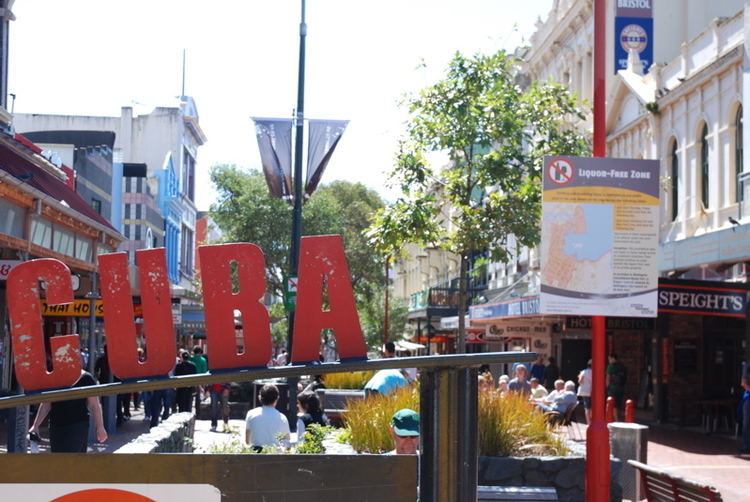 | ||
Cuba Street is one of the most prominent streets in Wellington, New Zealand.
Contents
- Map of Cuba Mall Te Aro Wellington 6011 New Zealand
- Location and origin
- Literary History
- Local people and activities
- Music and venues
- References
Map of Cuba Mall, Te Aro, Wellington 6011, New Zealand
Location and origin
Named after an early (1840) settler ship to New Zealand, the Cuba, it is to the south of the CBD, but still in the inner city. Cuba Street was once the route of the Wellington trams. Following the removal of the rails, the middle section of the street was closed to traffic in 1969, and is one of the busiest areas of pedestrian activity in Wellington. Since 1995, Cuba Street has been a registered Historic Area under the Historic Places Act 1993, with numerous buildings being of historic significance, the Bank of New Zealand building being one of those.
Literary History
Mary Taylor (1817-1893), lifelong friend and correspondent of author Charlotte Brontë owned and ran a small Cuba Street general store, circa 1840-1860. The shop no longer exists but a heritage storyboard at the intersection of Cuba and Dixon streets commemorates her.
Local people and activities
It is one of the more bohemian areas of Wellington, and is the home to an eclectic collection of cafes, op-shops, boutique, small fashion stores, art galleries, and music shops. It is the centre of one of the four 'quarters' of downtown Wellington, the Cuba Quarter (the others being centred on Lambton Quay, Courtenay Place and Willis Street). The northern end is more commercial, with an abundance of retail stores, cafes and restaurants. While the southern end (known as the 'top' of Cuba Street, or upper Cuba) is more sparsely occupied but has seen a revival in recent years. In the mid 70's to early 80's, "Mid Cuba" or Vivian Street (which crosses Cuba St) was Wellington's notorious Red light district, where prostitutes would loiter, strip clubs, peep shows and gay bars sat side by side. In recent years, remnants of the red light district are still visible, but sparse.
Cuba Street was also popular with many members of Wellington's homeless community, including the Wellington icon Blanket Man.
The street is regarded by most New Zealanders as a nexus of creativity and artistic production, featuring buskers, exhibition spaces, protests, stone carving, and other forms of expression. In 2005, the new Wellington Arts Centre was established in Abel Smith Street, a half block from upper Cuba Street. Within a few blocks are Enjoy Gallery, {Suite} Gallery, Peter McLeavey Gallery, the Moko (Tattoo) Museum, Thistle Hall, Victoria University of Wellington Faculty of Architecture and Design, and Access Radio.
The Bucket Fountain is a prominent sculpture in the pedestrianised part of the street.
Music and venues
The Cuba Street Carnival is a biennial street party celebrating Cuba Street.
Fat Freddy's Drop's first album, Live at the Matterhorn was recorded at the bar. Other venues in the area include Hotel Bristol, San Francisco Bathhouse, Bar Bodega, J.J. Murphy's, Southern Cross, S&M Bar, Midnight Espresso, Olive, K Bar, Hope Brothers, Havana Bar, Good Luck, The Duke, and Logan Brown. The lower end of Cuba Street ends at Wellington Town Hall, Civic Square, Michael Fowler Centre, and Wakefield Street.
